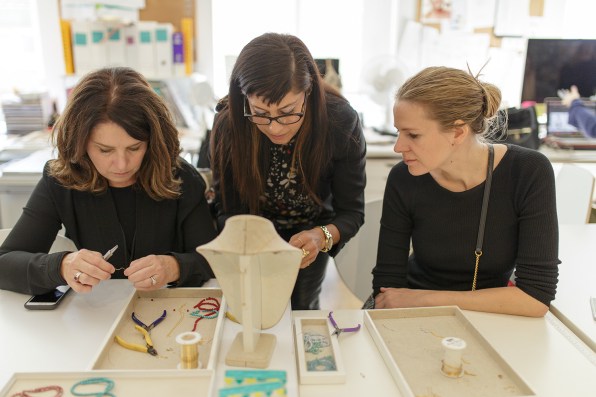Many people assume that the social-selling model–where women sell products to their friends in their homes–had gone the way of the Tupperware party. But since it launched in 2007, Stella & Dot has proven naysayers wrong. It now has a stable of three brands that include Keep Collective, which is a personalized charm bracelet and necklace line; Stella & Dot, the flagship costume jewelry and accessories line; and the Ever skin care line. Collectively, the brands now bring in $300 million in annual revenue, with over 50,000 sellers across six countries. Over the last nine years, Stella & Dot has paid its sellers over $350 million in commissions.
To get there, Stella & Dot had to reinvent that sales concept for the digital era. The brand’s army of sellers–or stylists, to use its own terminology–have customized web pages from which to sell products and actively use social media as a marketing tool. The company believes that its sellers are able to forge strong one-on-one relationships and offer personalized service rather than a pure e-commerce play. And it’s helped accelerate the growth of social commerce as businesses like Beautycounter, Rodan & Fields, and Chloe and Isabel have adopted similar sales models.
But on a recent visit to the Stella & Dot’s New York design studio for the Fast Company Innovation Festival, it became clear that without beautiful and well-made products, the entire business model would come undone. Rahul Gupta, the company’s director of product development for jewelry, points out that because sales happen in such a personal, intimate way, customers hold each seller responsible for the product assortment and quality. “If you go to a store like Bloomingdale’s or Macy’s and there’s something wrong with a product you buy, you might get mad at the company,” he says. “Here, it’s all about personal relationships. For our stylists to be successful, they need to be able to confidently serve their customer base without the fear of something falling apart.”

Blythe Harris, the company’s cofounder and chief creative officer, says that it is equally important to have a constant stream of fashion-forward new pieces so that stylists have new products to show their clients all year round and enough variety to suit many tastes. This means that the design team needs to be working to produce hundreds of new products a year that are released seasonally.
Unlike many other costume jewelry brands, Stella & Dot is not simply buying products from other manufacturers. The team designs every product from scratch, much the way a fine jeweler would. (Harris, Gupta, and many other designers have a background in fine jewelry, working at brands like De Beers, LVMH, and Movado.) I see some of this process at work at the New York design studio, where the walls are covered with colorful mood boards, designers are sketching future pieces, and there are workshop tables set out so they can begin creating samples.
But to keep up with this pace of creation and innovation, Harris must keep her team’s creative juices flowing. She’s given a lot of thought to how to keep them energized, and she shares her secrets here.
ENCOURAGE HANDS-ON MAKING
In the modern workplace, so much creation happens on screens. This is true even in the world of jewelry making where designers create pieces on computer programs, using tools like CAD, 3D imaging, and 3D printing. While Harris believes these new technologies are valuable, there’s also something to be said about getting your hands dirty.
At the Stella & Dot design studios, Harris installed jewelry benches where people can play with beads, metals, and other materials. But for people in other industries, this might mean moving to pen and paper for a while, or drawing out mind maps on a blackboard.
It’s important for people throughout the organization to have an opportunity to escape from their computers. When members of the marketing team stopped by the design studio recently, Harris brought Stella & Dot’s print designer in to teach everybody how to do block printing. “Getting out of your comfort zone with whatever medium you’re working with as a creative, and really getting your hands on a different technique, often sparks a lot of creativity,” she says.

DISRUPT YOUR ROUTINE
Harris believes strongly in taking inspiration trips. She was just in Chile, learning about local artisans. She’s created entire collections after particularly inspiring trips to India and France. To this end, Stella & Dot invests heavily in sending Harris and other designers to foreign countries.
But you don’t have to spend a lot of money to see things you wouldn’t ordinarily see. An important part of this process is learning new things. So Harris also encourages her team to take classes in new fields. For instance, architecture has been particularly helpful to members of the design team. “If you don’t have the budget to travel, you can disrupt your routine by going to work a different way, go to a new restaurant, or find ways to meet new people,” Harris says. “When you disrupt your thinking like that, it actually slows down time, and you start to be able to take in all your creative inputs differently.”
TIME MANAGEMENT
It’s not particularly sexy, but organizing your time well can be the most important way to support creativity. For Harris and her team, it has been very productive to cluster creative activities together. “I block out Fridays for only creative concepting time,” she says. “You’re in a different mental state when your creativity is unleashed. You need to manage your time so that you’re not constantly interrupted.”
This also means doing administrative tasks in a block, so Harris sometimes has days when all she focuses on is budgeting and planning out the year. It’s worth it, she feels, because it allows her to spend entire days drawing at her own pace or coming up with new themes for her new collection without the worry that she will somehow get pulled into a meeting. “It takes a while to get back to being creative,” she says. “It’s a very inefficient use of your time to have to go from using your executive thinking to tapping into your imagination.”
While collaboration and social engagement can sometimes be great for boosting creativity, it is also important to spend some time in solitude, Harris says. Solitude can give you the opportunity to give yourself the space and time to think through your ideas.







